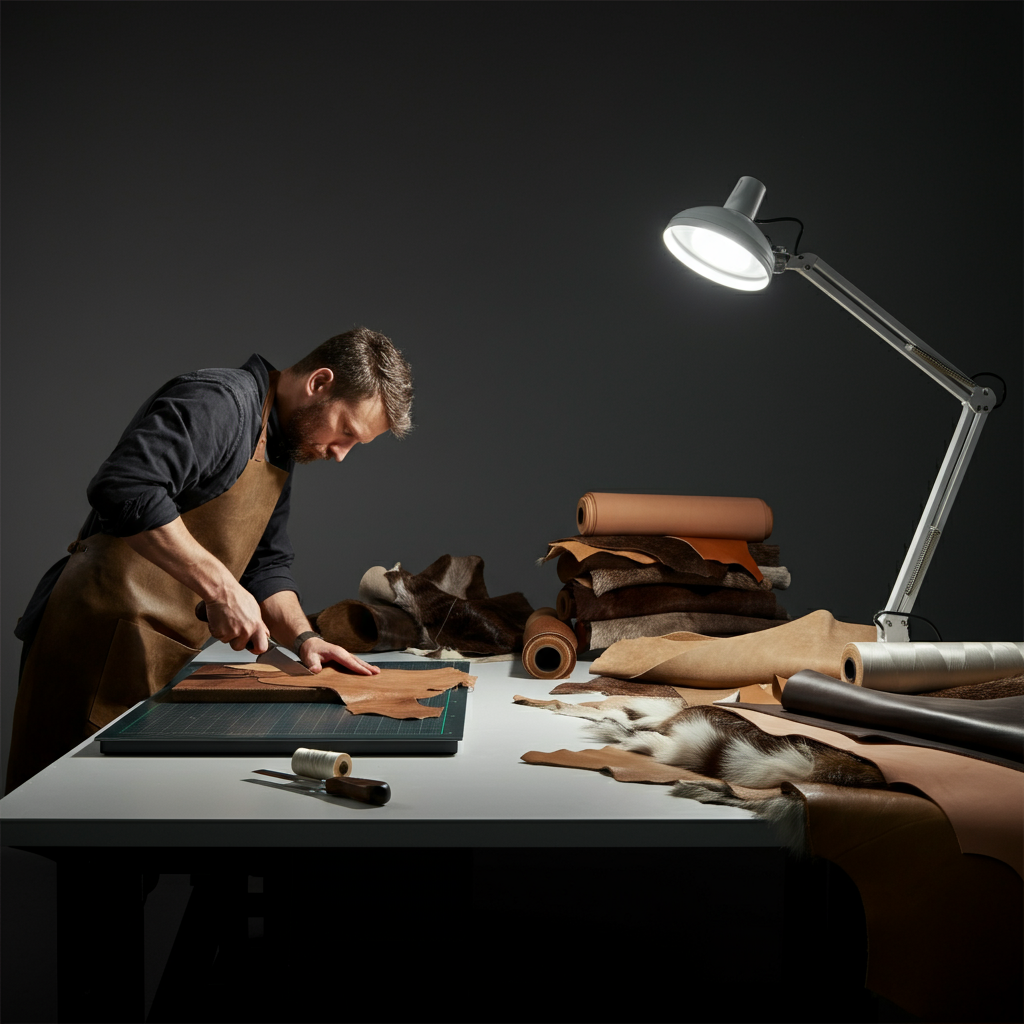The art of working with animal hides has shaped human civilization for millennia, but few tools have maintained their relevance across centuries quite like the Zuschneidfell. These specialized cutting hides, primarily sourced from cattle or other large animals, continue to play a pivotal role in modern craftsmanship, bridging traditional techniques with contemporary innovation. As artisans worldwide seek sustainable alternatives to synthetic materials while maintaining the highest standards of quality, Zuschneidfelle have emerged as both a link to our crafting heritage and a solution for today’s environmental challenges.
Historical Foundations and Traditional Significance
Zuschneidfelle, literally translated as “cutting hides” in German, have their roots in medieval European craftsmanship. These thick, durable leather surfaces originally served as protective layers for workbenches where artisans would cut, shape, and form materials without damaging their tools or work surfaces. Unlike ordinary leather, Zuschneidfelle were specifically prepared to withstand repeated cutting, hammering, and shaping operations while maintaining their structural integrity.
The preparation process for traditional Zuschneidfelle involved careful selection of hides from mature cattle, followed by specialized tanning methods that preserved the natural grain while creating a resilient, self-healing surface. Master craftsmen would often inherit these cutting hides from their predecessors, with some Zuschneidfelle serving workshops for decades. The surface would gradually develop character marks and indentations that actually enhanced their functionality, creating a textured workspace that provided better grip and control during delicate operations.
This historical significance extends beyond mere functionality. Zuschneidfelle represented the craftsman’s commitment to quality and durability. In guilds across Europe, the condition and age of a master’s cutting hide often reflected their skill level and dedication to their craft. These hides became silent witnesses to countless hours of meticulous work, absorbing the oils from hands and tools while developing a patina that told the story of the craftsman’s journey.
Contemporary Applications Across Industries
Today’s craftsmanship landscape has embraced Zuschneidfelle across diverse industries, each adapting these traditional tools to meet modern requirements. In high-end leather working, artisans continue to rely on Zuschneidfelle for their superior cutting properties. The natural give of the hide prevents blade dulling while providing enough resistance to ensure clean, precise cuts. Luxury handbag manufacturers and bespoke shoe makers particularly value this characteristic, as it allows them to work with expensive materials without fear of costly mistakes.
The jewelry making industry has also discovered the benefits of Zuschneidfelle, particularly in metalworking applications. When forming precious metals, the slightly yielding surface of the hide provides the perfect balance between support and cushioning. This prevents marring of delicate pieces while allowing craftsmen to achieve the subtle curves and textures that distinguish handmade jewelry from mass-produced alternatives.
Bookbinding, an art form experiencing renewed interest in our digital age, relies heavily on traditional Zuschneidfelle for edge work and tooling operations. The hide’s ability to absorb impact while maintaining firmness makes it ideal for the precise pressure control required in gold tooling and embossing. Contemporary bookbinders working on restoration projects or creating limited edition volumes find that synthetic alternatives simply cannot replicate the nuanced feedback that Zuschneidfelle provide.
In the world of fine woodworking, artisans use these cutting hides for carving operations where traditional workbenches might be too hard or unforgiving. The natural oils in the hide help prevent tools from sticking while the flexible surface accommodates irregular shapes and curved work pieces. This application has proven particularly valuable in restoration work, where preserving original patina and avoiding accidental damage is paramount.
Integration with Modern Techniques
The marriage of traditional Zuschneidfelle with contemporary craftsmanship techniques has yielded fascinating innovations. Modern artisans have developed hybrid approaches that combine the time-tested properties of cutting hides with precision tools and techniques. For instance, laser cutting operations often employ Zuschneidfelle as backing materials, where the hide’s ability to absorb excess energy prevents back-reflection while protecting the work surface.
Computer-controlled cutting systems in textile and leather industries have found that Zuschneidfelle provide superior results compared to synthetic alternatives. The natural variation in the hide’s density creates micro-adjustments in cutting pressure that actually improve edge quality, particularly when working with challenging materials like exotic leathers or technical fabrics.
Digital documentation of traditional techniques has also enhanced the value of Zuschneidfelle. Craftsmen can now share detailed videos and tutorials showing proper techniques for maintaining and using these hides, preserving knowledge that might otherwise be lost. This digital preservation has led to renewed interest among younger artisans who are rediscovering the benefits of traditional tools.
Sustainable Practices and Environmental Considerations
The environmental consciousness of modern craftsmanship has positioned Zuschneidfelle as champions of sustainability. Unlike synthetic cutting mats that eventually degrade and require disposal, properly maintained Zuschneidfelle can last for generations. This longevity aligns perfectly with the growing movement toward sustainable craftsmanship and reduced environmental impact.
Modern tanning processes for Zuschneidfelle have evolved to minimize environmental impact while maintaining traditional quality standards. Vegetable tanning methods, which use natural tannins from plant sources, have experienced a renaissance as artisans seek materials that align with their environmental values. These eco-friendly tanning processes not only reduce chemical pollution but also create hides with enhanced longevity and improved working characteristics.
The circular economy principles embraced by many contemporary craftsmen find perfect expression in Zuschneidfelle usage. When a cutting hide finally reaches the end of its working life, it can often be repurposed for other applications or composted naturally. This cradle-to-grave sustainability contrasts sharply with synthetic alternatives that contribute to plastic waste accumulation.
Challenges in Modern Implementation
Despite their advantages, Zuschneidfelle face several challenges in contemporary craftsmanship. The primary obstacle is availability, as fewer suppliers specialize in preparing proper cutting hides. Many modern craftsmen struggle to find authentic Zuschneidfelle that meet traditional quality standards, often settling for inferior alternatives that lack the durability and performance characteristics of properly prepared hides.
Cost considerations also present challenges. High-quality Zuschneidfelle require significant investment compared to synthetic alternatives, making them less attractive to hobbyists or small-scale operations. However, experienced craftsmen understand that the long-term value proposition favors traditional hides, as their durability often makes them more economical over time.
Storage and maintenance requirements can also deter modern artisans accustomed to low-maintenance synthetic materials. Zuschneidfelle require proper humidity control, regular conditioning, and careful handling to maintain their properties. In climate-controlled modern workshops, these requirements are manageable, but they do require knowledge and commitment that many contemporary craftsmen lack.
Future Opportunities and Innovation
The future of Zuschneidfelle in modern craftsmanship appears bright, driven by growing appreciation for sustainable practices and authentic materials. Educational initiatives are helping preserve traditional knowledge while adapting it for contemporary applications. Craft schools and artisan workshops are increasingly incorporating Zuschneidfelle training into their curricula, ensuring that future generations understand both the practical benefits and cultural significance of these traditional tools.
Innovation in hide preparation and treatment promises to address some current challenges while enhancing traditional benefits. Research into natural conditioning agents and preservation methods may extend the useful life of Zuschneidfelle while reducing maintenance requirements. These developments could make traditional cutting hides more accessible to a broader range of craftsmen.
The growing maker movement and renewed interest in handcrafted goods create expanding markets for tools and materials that enable superior craftsmanship. Zuschneidfelle, with their proven track record and sustainable credentials, are well-positioned to benefit from this trend.
Conclusion
Zuschneidfelle represent more than mere tools in the modern craftsman’s workshop; they embody the continuity of human creativity and skill across generations. Their successful adaptation to contemporary applications while maintaining traditional characteristics demonstrates the enduring value of time-tested solutions. As modern craftsmanship continues to evolve, balancing efficiency with authenticity and sustainability with performance, Zuschneidfelle offer a tangible connection to our crafting heritage while meeting the demands of today’s environmentally conscious artisans.
The challenges of availability, cost, and maintenance are not insurmountable obstacles but rather opportunities for innovation and education. By embracing both the traditional wisdom embodied in Zuschneidfelle and the possibilities offered by modern techniques, contemporary craftsmen can achieve levels of quality and sustainability that honor the past while building toward a more thoughtful future. In an age of increasing automation and mass production, these humble cutting hides remind us that some aspects of craftsmanship cannot be improved upon, only preserved and cherished.



